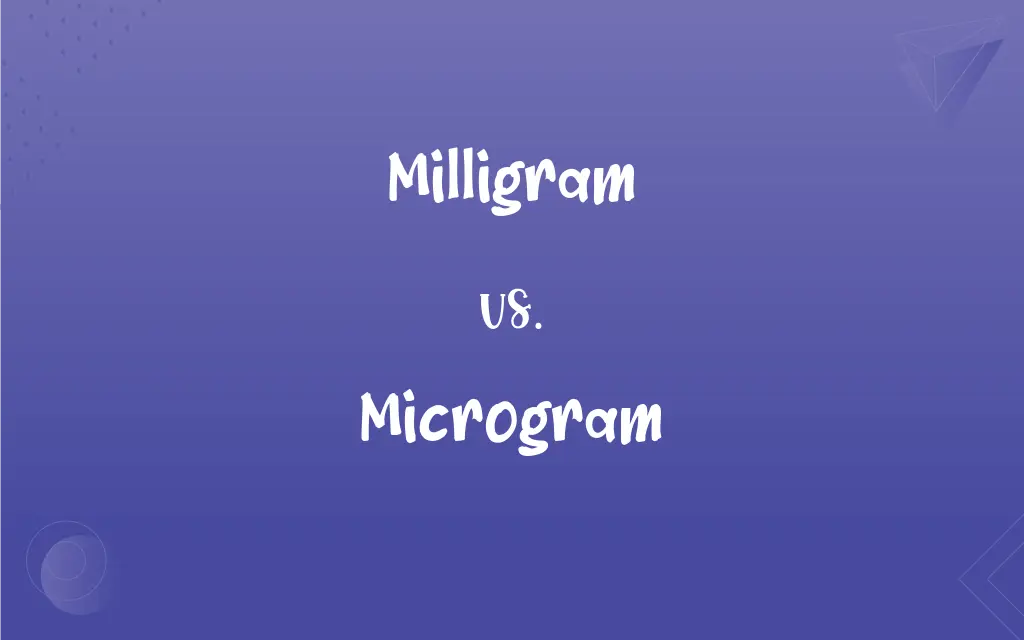Milligram vs. Microgram: What's the Difference?
Edited by Aimie Carlson || By Janet White || Published on February 26, 2024
A milligram (mg) is a unit of mass equal to one thousandth of a gram, while a microgram (µg) is one millionth of a gram; hence, 1 mg equals 1000 µg.

Key Differences
A milligram, abbreviated as mg, is a metric unit of mass equal to one thousandth (1/1000) of a gram. It is commonly used in medicine to dose medication, in cooking for precise ingredient measurements, and in science for small-scale experiments. On the other hand, a microgram, denoted as µg or mcg, is a unit of mass that is even smaller, amounting to one millionth (1/1,000,000) of a gram. This unit is crucial in fields like biochemistry and pharmacology, where extremely small quantities can have significant effects.
In the context of measurement, the milligram represents a quantity larger than the microgram. For example, in nutritional labeling, ingredients might be listed in milligrams if their required quantities are relatively larger, such as sodium or vitamin C. Conversely, vitamins like B12 or hormones may be measured in micrograms, reflecting their effectiveness in smaller amounts.
Precision in measurement is key in both units. When using milligrams, one is dealing with a unit that allows for fairly fine measurements in everyday contexts like dietary supplements or the concentration of chemicals in water. Micrograms, however, offer an even greater precision, which is essential in scientific research involving DNA, hormones, or airborne pollutants, where even minute quantities can be crucial.
The transition from milligrams to micrograms is a leap in sensitivity and specificity of measurement. In pharmaceuticals, for instance, certain drugs require dosing in milligrams, as their therapeutic window is broader. In contrast, more potent substances, such as certain hormones or toxic substances, are dosed in micrograms, reflecting the need for extreme precision due to their high potency.
Understanding the difference between these two units is vital in various scientific and medical fields. A milligram, being a larger unit, is more commonly encountered in everyday life, such as in grocery store scales or nutritional information. Micrograms, being much smaller, are less commonly seen but are critical in specialized scientific measurements where extreme accuracy is required for tiny quantities.
ADVERTISEMENT
Comparison Chart
Basic Definition
1/1000 of a gram
1/1,000,000 of a gram
Common Usage
Medication dosage, cooking measurements
Biochemical research, hormone levels
Scale of Measurement
Larger unit, less precise
Smaller unit, more precise
Everyday Example
Measuring caffeine in coffee
Measuring Vitamin D in a dietary supplement
Milligram and Microgram Definitions
Milligram
A milligram is a unit of mass equal to one thousandth of a gram.
The doctor prescribed 500 milligrams of ibuprofen for pain relief.
ADVERTISEMENT
Microgram
A microgram is a unit of mass equal to one millionth of a gram.
The lab test detected 50 micrograms of the substance in the sample.
Milligram
In pharmacology, a milligram is used for dosing many medications.
Each tablet contains 10 milligrams of the active ingredient.
Microgram
Micrograms are crucial in measuring doses of highly potent drugs.
The vaccine is effective with just 10 micrograms per dose.
Milligram
Milligrams are used in laboratories to measure small quantities of substances.
The experiment required precisely 5 milligrams of the chemical compound.
Microgram
Micrograms are used in biochemistry for precise measurements of small molecules.
The DNA sample was quantified at 2 micrograms.
Milligram
In everyday contexts, milligram serves as a practical unit for measuring light weights.
The gold necklace was weighed at 200 milligrams.
Microgram
In environmental science, pollutants are often measured in micrograms.
The air quality report showed particulate matter levels at 35 micrograms per cubic meter.
Milligram
Milligram is often used in nutrition to quantify vitamins and minerals in food.
This cereal contains 150 milligrams of calcium per serving.
Microgram
Nutrition labels may use micrograms to measure trace nutrients.
Each tablet provides 400 micrograms of folic acid.
Milligram
A unit of mass equal to one thousandth (10-3) of a gram. See Table at measurement.
Microgram
A unit of mass equal to one thousandth (10-3) of a milligram or one millionth (10-6) of a gram.
Milligram
An SI unit of mass, equivalent to one thousandth of a gram. Symbol: mg
Microgram
A unit of mass equal to one millionth of a gram, or 0.000 001 grams.
Milligram
A measure of weight, in the metric system, being the thousandth part of a gram, equal to the weight of a cubic millimeter of water, or .01543 of a grain avoirdupois.
Microgram
One millionth (1/1,000,000) gram
Milligram
One thousandth (1/1,000) gram
FAQs
How many micrograms are in a milligram?
There are 1000 micrograms in a milligram.
Why are micrograms important in pharmacology?
Micrograms are used in pharmacology for dosing highly potent drugs where precision is crucial.
What are common uses for milligrams?
Milligrams are commonly used in medicine for dosing, in cooking for measuring ingredients, and in science for experiments.
What is a milligram?
A milligram is a unit of mass equal to one thousandth of a gram.
Can micrograms be used in environmental science?
Yes, micrograms are used to measure pollutants and airborne particles in environmental science.
What is the abbreviation for microgram?
The abbreviation for microgram is "µg" or "mcg."
What is an example of milligram usage in food?
Milligrams are used to measure nutrients like sodium or sugar in food.
Is a milligram bigger than a microgram?
Yes, a milligram is 1000 times bigger than a microgram.
Can milligrams be used in measuring water quality?
Yes, milligrams are used in measuring the concentration of chemicals or minerals in water.
What is the abbreviation for milligram?
The abbreviation for milligram is "mg."
Are micrograms used in DNA research?
Yes, micrograms are used in DNA research for precise measurement of small DNA samples.
How is a milligram used in medicine?
In medicine, milligrams are used for dosing many over-the-counter and prescription medications.
Are micrograms relevant in hormone measurement?
Yes, hormones are often present in very small amounts, so they are measured in micrograms.
Is it common to convert milligrams to micrograms?
Yes, conversion between milligrams and micrograms is common in fields requiring precise measurements.
Why might a nutrient be measured in micrograms on a nutrition label?
Nutrients like vitamins and minerals, which are effective in very small amounts, are often measured in micrograms on nutrition labels.
How are micrograms significant in air quality monitoring?
Micrograms are used to measure fine particles and pollutants in the air, indicating air quality.
Are milligrams used in animal medicine?
Yes, milligrams are used in veterinary medicine for dosing medications for animals.
What is a practical example of milligram use in everyday life?
A common example is the measurement of caffeine content in coffee, often expressed in milligrams.
Can both milligrams and micrograms be used in laboratory settings?
Yes, both units are used in labs, with milligrams for larger quantities and micrograms for very small quantities.
What is the symbol for milligram and microgram?
The symbol for milligram is "mg," and for microgram, it's either "µg" or "mcg."
About Author
Written by
Janet WhiteJanet White has been an esteemed writer and blogger for Difference Wiki. Holding a Master's degree in Science and Medical Journalism from the prestigious Boston University, she has consistently demonstrated her expertise and passion for her field. When she's not immersed in her work, Janet relishes her time exercising, delving into a good book, and cherishing moments with friends and family.
Edited by
Aimie CarlsonAimie Carlson, holding a master's degree in English literature, is a fervent English language enthusiast. She lends her writing talents to Difference Wiki, a prominent website that specializes in comparisons, offering readers insightful analyses that both captivate and inform.






































































